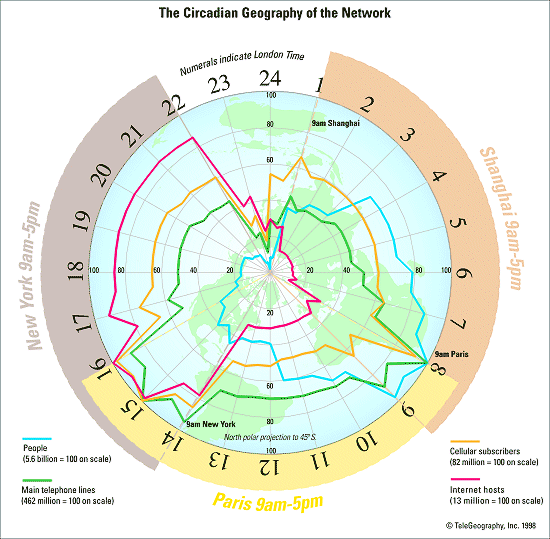![[Home]](http://meatballwiki.org/meatball.gif) InternetCycles
InternetCycles
MeatballWiki | RecentChanges | Random Page | Indices | CategoriesThe Internet runs on cycles that are rather unique to it, but only insomuch as its cycle is the superposition of many RealWorld cycles. This is much like sound is the superposition of many sine waves. If you note that in general the heaviest use of the Internet comes from the workforces of the world.

Source: http://www.telegeography.com (1998). See also Telegeography 1999: Global Telecommunications Traffic Statistics and Commentary, edited by Gregory C. Staple, 1998, TeleGeography?, Inc., Washington, DC. (Alternate sources: [1], AtlasOfCyberspace p.71.)
This diagram is extremely fascinating. Note first that the artist has highlighted the office hours of three major regions: Shanghai, Paris, and New York. In the period during the day where few people are working in offices, the collective communication infrastructure is at its daily low. However, still, the Internet manages only to peak during North American's business hours, and those mostly dominated by the east coast. Indeed, this traffic remains fairly flat, only increasing past a fairly steady plateau due to the superposition of Paris traffic.
On the other hand, mainland telephone traffic soars at the complete opposite side of the world, especially when Shanghai and Paris work hours overlap. This is also the part of the world where the population histogram is so heavily weighted.
Finally, cell phone traffic remains relative stable throughout the world, only spiking as office hours overlap, and only dipping during the lull times around midnight UTC.
So, we may conclude that the Internet is very heavily dominated by American business(especially on the east coast), not very influential in Asia, and somewhat influential in Europe. This shows that the minority rich part of the world dominates the Internet, as we all know.
- That's a lovely diagram. Note that the underlying map of the world is aligned with the UK (and the Greenwich meridian) at 9am. Seems odd, but I suppose that lines every country up with the start of its "office hour" on the graph.
Anecdotal hypothesis
Having used the Internet since 1995, I am a relatively late comer. Nonetheless, these are the usage patterns that I have observed. They may diverge from the above due to the nature of sites that I visit (usually non-commercial), and mostly because they are subjectively qualitative rather than quantitative in nature.
I too have observed heaviest usages generally during work hours, and if you also consider that the heaviest use of the chat forums comes from students, much of this will make sense. Lately, as more people get connected in their homes, I also think the heaviest usage times come just after dinner. But perhaps this is only to consumer sites.
On the daily rhythm, I have noticed peak usages during daylight hours in North America, but there continues to be heavy traffic until around 8am UTC when it drops to almost nothing until 9am UTC when the English workforce logs onto the Internet. This time corresponds to 3/4am EST and 12/1am PST, when North America is sleeping, and 6pm Tokyo time when I assume the Japanese workforce is having dinner. Consequently, HackingAtNight is still the norm amongst bandwidth hogs--including pirates.
Weekends are universally low usage. Peak times for the week are usually Wednesday or Thursday, with Friday and Monday being rather low. American holidays can severely change the usage patterns of a website. Either they will drop to nearly nothing if your demographic is the workforce, or grow rather large if your demographic are students. I imagine similar results for their respective locales of websites that use languages other than English or are region specific.
Most subtle yet dramatic is the shift that comes from the summer school session in America. Since chat forums are mostly students, when they go home for the summer away from their Internet connections, the 'net traffic tends to slow down. When they come back in September, the SignalToNoiseRatio on these forums drops considerably. Also, since it is summer, people are more likely to be outside instead of at home in front of their keyboards.
This September cycle was well known on Usenet, so when AOL offered NNTP service in August 1993, it began the largest sustained jump in crapflooding of Usenet ever. This was known as TheSeptemberThatNeverEnded. -- SunirShah
New Year's is also the worst time of the year for OnlineCommunities. cf. NewYearsVandal.